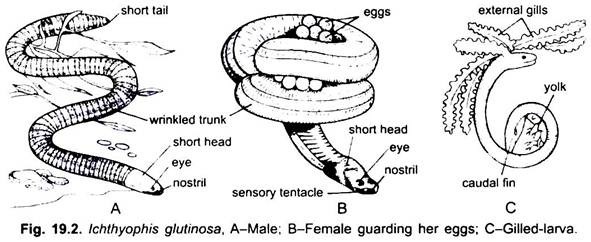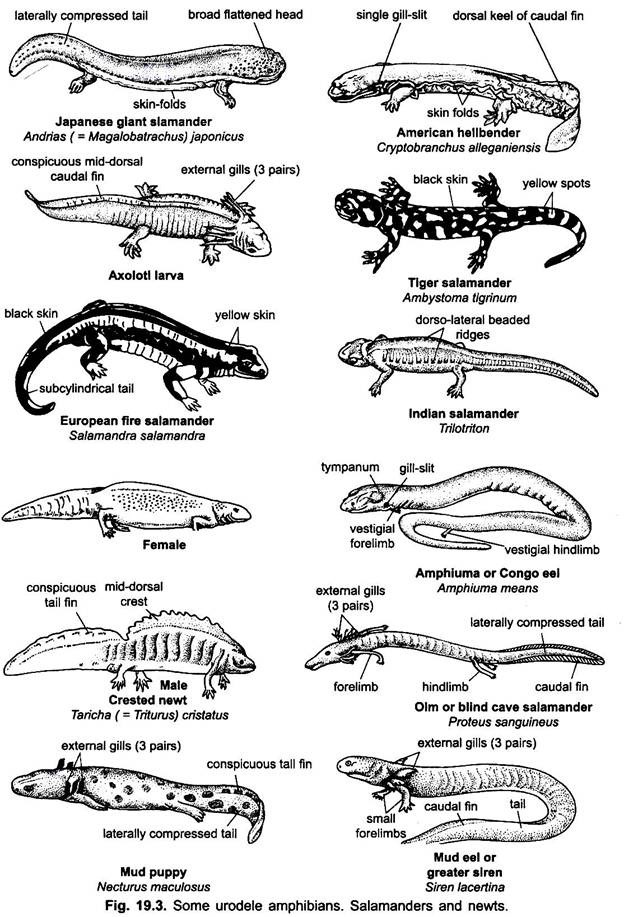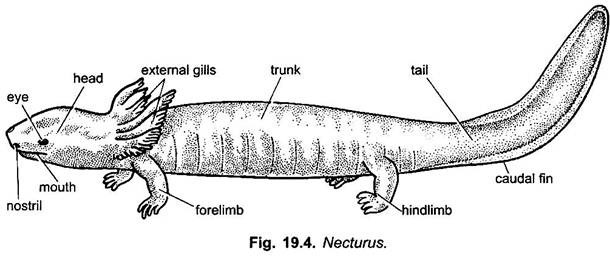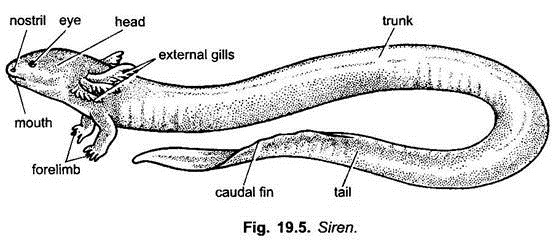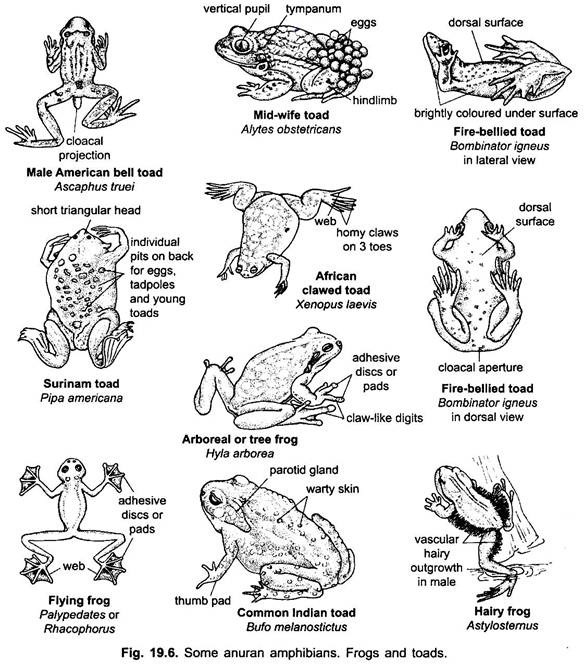In this article we will discuss about the representative types of amphibia with the help of suitable diagrams.
Ichthyophis:
Ichthyophis (blindworm) (Fig. 19.2) is a worm-like caecilian with ring-like grooves on the body. It is about 30 cm long. It burrows in moist earth. In the skin are numerous minute concealed scales (absent in Siphonops). Head is small and depressed, with solidly built bony skull and microscopic eyes are covered with opaque skin so that it is blind. On the head, between the eyes and nostrils, is a pair of special protrusible sensory tentacles lodged in pits, they are kept moist by the secretion of Harderian glands.
The tentacles are used for tasting food. Middle ear and tympanum are absent, so it cannot hear. There is a long trachea, the right lung is long but the left lung is reduced. There are no limbs or girdles and a sternum is lacking. Vertebrae are amphicoelous. Anus is sub-terminal so that there is very short tail.
ADVERTISEMENTS:
The male has an eversible copulatory organ bearing hooks. Ichthyophis is primitive but its tentacles, absence of tail, and copulatory organ are specialised features. It is found underground in India, Sri Lanka, Malaya and Siam.
The female lays 20 eggs in a burrow near water. (Some genera of Apoda are viviparous, such as Geotrypetes and Typhlonectes). The female coils around the fertilised eggs. They are large and yolky and covered with albumen having twisted chalazae, the chalazae join the eggs in a bunch. Cleavage is meroblastic. Embryos develop around yolk sacs.
The gilled-stage is passed within the egg. Each embryo having three pairs of long, plumed gills. The gills are lost before the embryo hatches, obviously these external gills are not respiratory but they probably absorb nourishment. The female then takes the eggs to shallow water where larvae hatch.
The larva has one pair of open gill-clefts and a caudal fin, it swims about coming to the surface to take air into its lungs. After a long period the gill-clefts close, tail fin is lost and the adult come to land for a burrowing life. Typhlonects is viviparous.
Salamanders and Newts:
ADVERTISEMENTS:
They belong to the order Urodela. The adult and larval urodeles differ little from each other. Larva has gills and gill-slits which may or may not persist in the adult. They are mostly aquatic animals, but a few are purely terrestrial in the adult state, merely return to the water to lay their eggs or deposit their larvae.
In adults eyes are small, sometimes functionless, and without lids except in Salamandride, Tympanic membrane and tympanic cavity are not developed. They are usually oviparous, rarely viviparous. In a few cases the larvae have the power of developing sexual organs and reproduce like adults. There are about 100 species.
Urodeles generally belong to two groups:
i. Perennibranchs:
ADVERTISEMENTS:
These retain gills and are permanently aquatic.
Examples: Proteus, Siren, Necturus.
ii. Caducibranchs:
Adults have no gills and so they become terrestrial.
Examples: Amphiuma Cryptobranchus, Megalobatrachus possess gill-slits in adult state, whereas Ambystoma, Triturus, Salamandra possess neither external gills nor gilt-slits in adult stage.
1. Cryptobranchus:
Cryptobranchus (Fig. 19.3.) is commonly known as American hellbender. It is a giant, fully aquatic salamander. It is semi-larval (incompletely metamorphosed) in adult stage. Body is large reaching a length of 60 cm or more. Head is broad, bears a pair of small lidless eyes.
Gills are absent in the adult but the first gill-cleft or spiracle remains open and acts as an outlet for water taken into the mouth during buccal respiration. Lateral line organs are well developed. Predaceous. Chiefly feeds on fishes. Sexes are separate.
Eggs are laid in gelatinous sacs pulled out into two long strings and are fertilised when the males deposit sperm masses near the egg laying females. Cryptobranchus is widely distributed over Eastern United States from the Great lakes to Georgia and Louisiana.
ADVERTISEMENTS:
2. Ambystoma:
Ambystoma or Amblystoma tigrinum (Fig. 19.3) is commonly known as tiger salamander. Body is elongated lizard-like, measures about 12 cm in length. The colour of the body is black with yellow patches. Skin is poisonous. Limbs are well developed, forelimbs bear four fingers and hindlimbs have five toes.
External gills are absent in the adult stage. Vertabrae are amphicoelous. Sexes are separate and fertilisation is internal. Larva is known as Axolotl. Ambystoma is found in North America from Southern Alaska to Mexico. Neotenic forms occur in mountain regions specially in Mexico.
Axolotl larva (Fig. 19.3.) possesses three pairs of external gills and a tail having a caudal fin. It exhibits the phenomenon of neoteny or paedogenesis. If the food and water are scarce and iodine is lacking in water then the larva does not metamorphose, retains their external gills and aquatic life, and becomes sexually mature to reproduce the young’s. Such morphologically immature but sexually mature larva is called Axolotl. Retention of larval characters is neoteny and reproduction by it is paedogenesis.
In case of abundant supply of food and water containing iodine compounds, the axolotl larva undergoes metamorphosis to become mature air-breathing terrestrial adult. Metamorphosis in axolotl is induced by injecting thyroid extract. Axolotl larva is found in the mountain regions of Mexico.
3. Salamandra:
Salamandra (Fig. 19.3) is a terrestrial salamander with a lizard-like body having strong limbs and a nearly cylindrical tail. Salamanders have no tympanic membrane or middle ear and tympanum, hence, they cannot hear. The adult has no gills, eyelids are movable. They have teeth on both jaws and also vomerine teeth. Vertebrae are opisthocoelous.
The interauricular septum is perforated. Salamadra maculosa, the European fire salamander, is black and yellow in colour, about 15 embryos develop in the oviducts. It is viviparous and when the young are born, they still have external gills, metamorphosis occurs later. Salamander atra of Switzerland lives in rapid Alpine streams. It is black in colour and is ovoviviparous, two eggs develop in the oviducts, when larvae hatch they have no external gills and they take to water.
4. Amphiuma:
Amphiuma means (Congo eel) (Fig. 19.3) has a long cylindrical body about 90 cm in length. Limbs are very small and rudimentary with two or three digits, they are of no value in locomotion. It is a semi-larval form of salamandrid derivation. The eyes are small and lidless. There are no gills in the adult but one pair of gill-clefts is retained.
It has lungs with a long trachea supported by cartilages. There is no sternum. Amphiuma has the largest erythrocytes of any animal, they are 80µ in diameter. Eggs are laid in water and the female coils itself around them for protection. It is a salamander found in American swamps and muddy waters.
5. Triton:
Triton (Fig. 19.3) is commonly known as European salamander. Body is elongated and cylindrical. Skin is soft and covered with slime. Scales are entirely absent. Fore- and hindlimbs are well developed. Forelimbs bear four fingers and hindlimbs bear five toes. Tail is provided with a median fin above and below. Fin is devoid of fin-rays. Mouth is wide having the paired external nostrils just above it. Eyes are small having the upper and lower lids.
Tympanum or eardrum is absent. In adults the gills are absent and respiration is by skin. Lateral line organs are found in the larva. Alimentary canal, excretory ducts and the gonadial ducts all open into the cloaca. It exhibits the marked sexual dimorphism. Male possesses a dorsal median crest. It is terrestrial animal. Triton is distributed in Europe and U.S.A.
6. Proteus:
Proteus (Fig. 19.3) is commonly known as olm or European blind cave salamander. It has an elongated eel-like body reaching up to the length of 5 cm. The skin has no pigment so the colour is whitish. Head is broad, eye rudiments are sunk deep in the head so that it is blind. It is neotenic permanent larva with three pairs of red-coloured branching external gills and two pairs of open gill-clefts, lungs are also present.
The tail is compressed and has a caudal fin. Limbs are weakly developed; the hindlimbs have two digits and are smaller than the forelimbs which have three digits. The skull is embryonic with persistent cartilaginous trabeculae. Pelvic girdle has long anteriorly directed pubo-ischium. It has no organ of Jacobson. It lives in the dark caves of central European mountains.
If Proteus is kept in light for long, it first becomes grayish and finally black in colour. If its young ones are reared in red light, well developed eyes appear and the skin becomes pigmented showing that the inherent basis for these characters has not been lost in this species.
7. Necturus:
Necturus (Fig. 19.4) is commonly known as mud puppy. Body is elongated measuring from 30-42 cm in length. Tail is long and bears a caudal fin. The general colour of the body is rusty brown with blackish spots.
It is a typical permanent neotenic larva and exhibits the following larval characters:
(i) Three pairs of external gills are present in the adult,
(ii) Two pairs of open gill-clefts.
(iii) Eyes are lidless.
(iv) Skull largely cartilaginous,
(v) Musculature larval,
(vi) Larval circulatory system,
(vii) Lateral line organs are present,
(viii) Permanently aquatic.
Lungs are also present. Organs of Jacobson are absent. Attempts have been made to force Necturus to undergo metamorphosis but no success has been achieved. Necturus is found in North America and Yugoslavia.
8. Siren:
Siren (Fig. 19.5) is commonly known as mud eel. It is a blackish salamander found only in U.S.A. Unlike other salamanders it has no hindlegs. It has an elongated eel-like body up to 60 cm long. It is a permanent larval form showing almost no adult characters. It is aquatic, has three pairs of external gills, lidless eyes and horny sheaths on jaws with no teeth.
It has small forelimbs with four digits, hindlimbs are absent. The tail has a caudal fin. The lower dermis has concealed papillae which look like scales. Fertilisation is external, unlike most urodeles. They are carnivorous and are found in muddy ponds and lakes.
Frogs and Toads:
Frogs and toads belong to the order Anura or Salientia. It includes about 2,200 species. Their body is short without tail. The vertebral column is short consisting of 9 vertebrae and a urostyle. On the head are the wide mouth, and the large eyes with well-developed eyelids and a transparent nictitating membrane.
The nasal apertures are placed far forward on the extremity of the snout and can be closed by membranous valves. In the auditory organ, the tympanic cavity and tympanic membrane are present. Tongue is absent in the Aglossa (e.g.. Xenopus). Ribs are absent. Limbs and girdles are present. Skin is scaleless but glandular. Fertilisation is external. Oviparous and development occurs in water.
1. Alytes:
Alytes obstetrican (Fig. 19.6) is commonly known as mid-wife toad. It has papillae on the skin both on the dorsal and ventral side. Tympanum is large, vocal sacs are absent. Vertebrae are opisthocoelous. It has a particular breeding habit. The male massages the cloaca of the female and eggs are laid in one string and fertilised by the male.
The male Alytes winds the string of eggs around its posterior body and thighs, then it buries itself in moist earth. It makes occasional trips to water to keep the eggs wet. When tadpoles are in an advanced stage and ready to hatch, the male plunges itself into water where tadpole larvae hatch and undergo metamorphosis. It is found in France and Italy.
2. Pipa:
Pipa pipa (Fig. 19.6) is commonly known as Surinam toad. It has several species found in Brazil, such as Pipa dorsigera and Pipa americana. It is an ugly toad which is aquatic.
It has a flat body. The head is short and broad with a pair of small tentacles in front of the small eyes. The skin has papillae having poison glands. Tongue is lacking and tympanum is absent. Forelimbs are small and their digits have small branching sensory processes at their tips. Hindlimbs are large with webbed digits. Vertebrae are opisthocoelous.
During the breeding season the male clasps are female; the oviduct of the female protrudes out more than 3 cm and is covered over her back, the male presses out the eggs which are then fertilised.
The dorsal skin of the female becomes soft and spongy, fertilised eggs are attached to her back, the male helping in the process of spreading them out evenly. Each fertilised egg sinks with the aid of enzymes into a pouch of the dorsal skin of the female, each pouch gets covered by a gelatinous lid or operculum made of mucus.
The lid can be opened; the eggs remain moist in the pouches. Eggs develop in these pouches which become highly vascular. The embryo has a yolk sac and develops a vascular tail for metabolic exchanges. No external gills are formed and after 80 days fully formed young ones emerge from the pouches. Thus, a primarily oviparous condition is substituted secondarily by a viviparous condition. After birth of young ones the female changes its dorsal skin.
3. Bombinator:
Bombinator (Fig. 19.6) is commonly called fire bellied toad. It is normally aquatic; the size is about 5 cm. The head and body are depressed, the dorsal surface is dark and has papillae, but the ventral surface and limbs have black, red and orange patches which look like fire.
Tympanic membranes and vocal sacs are absent, and Eustachian tubes are small. When it is disturbed it lies on its back assuming a warning attitude and shows its fiery patches as warning colours, then it feigns death to escape its enemies. It is found in Europe and China.
4. Bufo:
Bufo melanostictus (Fig. 19.6) is commonly called true toad. It is found all over the world except Australia and Madagascar. It is terrestrial and noctural. In the daytime it hides under stones in damp places. The skin is dry and rough having warts with poison glands, it takes almost no part in respiration. Behind each large tympanum is a poison-secreting parotoid gland. Hindlimbs are long with practically no web. There are no teeth.
Epicoracoids of pectoral girdle overlap. The liver has only two lobes. Toads have a Bidder’s organ anterior to each gonad; they atrophy in adult females but persist in males, in either sex it can develop into a new ovary. If testes are removed the Bidder’s organs become ovaries in the male, they become functional so that there is a complete sex reversal.
They may be endocrine glands. Toads have no calcareous glands of Swammerdam. The ureters open on common papilla. Period of metamorphosis is short but the young toads take several years to become full-grown adults.
5. Hyla:
Hyla (Fig. 19.6) is commonly known as tree frog. It is an arboreal frog. The skin is smooth dorsally but there are papillae on the ventral side. Some species are dark but others are brown or green according to the colour of trees in which they live. Some species have powerful poison glands. They have teeth only in the upper jaw. There is very little web between the digits.
The digits terminate in plate-like knobs which are glandular and adhesive discs. They are not suctorial but have a moist, corrugated lower surface with mucus. An extra joint or intercalary cartilage between the last two phalanges of each digit facilitates adjustments of the adhesive discs for climbing trees.
Hyla is cosmopolitan found in damp forests, but it is not found in India and Africa. Several species are confined only to the New World. Hyla goeldii female carries eggs on her back. The Jamaican Hyla places its eggs in small pools of rain which have collected in large leaves.
6. Rhacophorus:
Rhacophorus (Fig. 19.6) is commonly known as flying frog. The body is slender. The limbs are thin and long with large feet having well developed web between the digits of all four limbs, and the digits bear rounded adhesive pads as in Hyla.
It lives in trees and can glide with outstretched limbs from tree to tree or from a tree to the ground. It also exhibits parental care by depositing eggs in the nests near water. It has the capacity to change the colour rapidly. Rhacophorus maculatus and Rhacophorus malabaricus are found in India. Rhacophorus pardalis is a Javanese flying frog.
